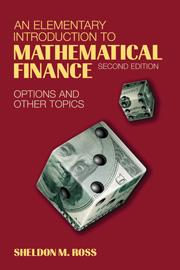Book contents
- Frontmatter
- Contents
- Introduction and Preface
- 1 Probability
- 2 Normal Random Variables
- 3 Geometric Brownian Motion
- 4 Interest Rates and Present Value Analysis
- 5 Pricing Contracts via Arbitrage
- 6 The Arbitrage Theorem
- 7 The Black–Scholes Formula
- 8 Additional Results on Options
- 9 Valuing by Expected Utility
- 10 Optimization Models
- 11 Exotic Options
- 12 Beyond Geometric Brownian Motion Models
- 13 Autogressive Models and Mean Reversion
- Index
12 - Beyond Geometric Brownian Motion Models
Published online by Cambridge University Press: 05 June 2012
- Frontmatter
- Contents
- Introduction and Preface
- 1 Probability
- 2 Normal Random Variables
- 3 Geometric Brownian Motion
- 4 Interest Rates and Present Value Analysis
- 5 Pricing Contracts via Arbitrage
- 6 The Arbitrage Theorem
- 7 The Black–Scholes Formula
- 8 Additional Results on Options
- 9 Valuing by Expected Utility
- 10 Optimization Models
- 11 Exotic Options
- 12 Beyond Geometric Brownian Motion Models
- 13 Autogressive Models and Mean Reversion
- Index
Summary
Introduction
As previously noted, a key premise underlying the assumption that the prices of a security over time follow a geometric Brownian motion (and hence underlying the Black–Scholes option price formula) is that future price changes are independent of past price movements. Many investors would agree with this premise, although many others would disagree. Those accepting the premise might argue that it is a consequence of the efficient market hypothesis, which claims that the present price of a security encompasses all the presently available information – including past prices – concerning this security. However, critics of this hypothesis argue that new information is absorbed by different investors at different rates; thus, past price movements are a reflection of information that has not yet been universally recognized but will affect future prices. It is our belief that there is no a priori reason why future price movements should necessarily be independent of past movements; one should therefore look at real data to see if they are consistent with the geometric Brownian motion model. That is, rather than taking an a priori position, one should let the data decide as much as possible.
In Section 12.2 we analyze the sequence of nearest-month end-of-day prices of crude oil from 3 January 1995 to 19 November 1997 (a period right before the beginning of the Asian financial crisis that deeply affected demand and, as a result, led to lower crude prices).
- Type
- Chapter
- Information
- An Elementary Introduction to Mathematical FinanceOptions and other Topics, pp. 213 - 232Publisher: Cambridge University PressPrint publication year: 2002



